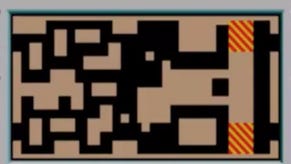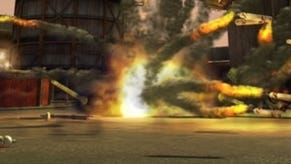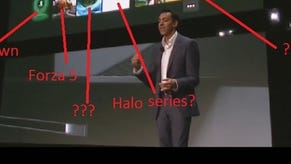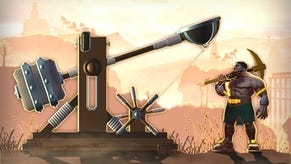Crackdown 2
Sequels equals kills, Agent.
Glowing jump pads, although initially seeming rather artificial, actually slot really well into Crackdown's simple genome - regular air boosts for this most sky-minded of titles - and Ruffian chains them into elaborate tangles at times, ping-ponging you around an entire map in the space of 30 seconds, or simply chucking you mischievously high into the air, where you can pick out a range of different scurrying targets, or, more likely, become the ultimate target yourself.
16 players means there's always a chance to find somewhere to catch your breath for a few seconds or build up a nice lingering rivalry with a handful of other people, but such is the speed of movement and the relentless pace of respawns that it can feel like you're playing against hundreds, and there's a smart scoring system that sees you rewarded with different points depending on the quality of each kill. The concrete-splintering ground-strikes seem to be most worthwhile. Throw in power-ups like extra shields, invisibility, and regular chances to change your weapons, and multiplayer becomes hard to put aside.
Eventually, however, it's into one of the flimsy-walled meeting rooms and onto a closer look at the single-player game. "Let's get cracking," says Ruffian producer James Cope (regularly namechecks Robotron 2084/is generally awesome), firing up the game before instantly looking rather embarrassed.

Crackdown is unlikely to go down in history for its plot alone - there were some dodgy people knocking around, and you killed a lot of them while jumping very high in the air and bravely driving over pedestrians - but it's nice to know that it had enough ticking away under the hood to kick off this sequel. Towards the steeper end of the original game's missions came an opportunity to put one Dr Baltazar Czernenko off the Open University grant application list for good. Czernenko was Shai Gen's head of dubious genetic research - although I doubt that was the exact job title on his business card - and in the course of ridding Pacific City of this deadly menace, you probably let a lot of his snaggle-faced, zombie-like Freaks loose.
That, it transpires, was probably an error. Once the Agency regained control of Pacific City at the end of the first Crackdown, it then lost it again quickly to the hordes of delightful infected mutants rolling around in its streets and alleyways. 10 years passed, in which the three islands were comprehensively trashed, and the population either fled or joined The Cell, a terrorist network dressed in the same foxy knitwear patterns beloved of City 17's resistance. The Cell hate the Freaks, but hate the Agency a little bit more, and they're totally rocking this season's thick rustic threads and cable knits.
Crackdown 2 starts out with the re-emergence of the Agency as a force in Pacific City. With a crippled infrastructure and only one active officer back online, it's up to you to fight off The Cell and take down the Freaks, or just spend your time donuting your car mindlessly in the streets before backflipping into a laundrette.
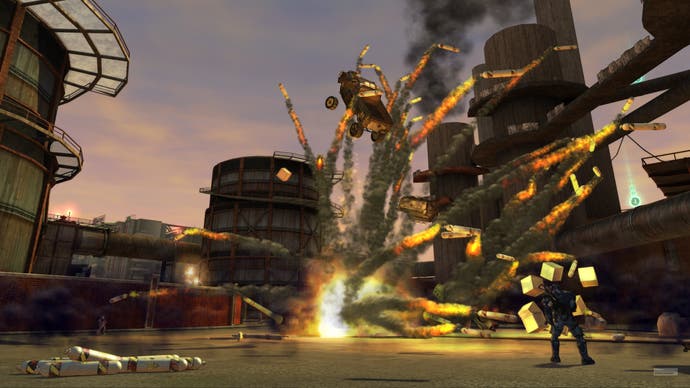
Promisingly, although Ruffian is eager to tell a deeper story this time around, this set-up is little more than a way of getting three factions into opposition, while also creating an environment in which the only people left on the streets are The Cell or the Freaks - i.e., people you can legitimately back over in an SUV, meaning you won't be impeding the progression of your driving skills. "People love running other people over," smiles Cope, before adding quickly: "in Crackdown. But too often we made that something that punished you at the same time. This time, we're making sure that doesn't happen."
Meanwhile the streets themselves will be familiar, but not entirely so. "It's not exactly the same city this time," Cope continues. "There's lots of new geometry in there: we wanted people to see familiar bits, but also wanted them to come back and see how it's all changed."
Mission accomplished: Pacific City was a wonderfully memorable playground, and for a lot of players it would be something of a shame to say goodbye entirely. Ruffian appears to have achieved a remarkable balancing act: retaining the very basic layout of the city and its three islands, keeping all the neighbourhoods and districts in roughly the same place, but then swooping in close to extensively redesign each of the individual areas. The docks, as deathmatch hinted at, are now gigantic and far more vertical, while the refinery is more elaborate, filled with new dead-ends, gantries and shortcuts to discover.

.jpg?width=291&height=164&fit=crop&quality=80&format=jpg&auto=webp)

